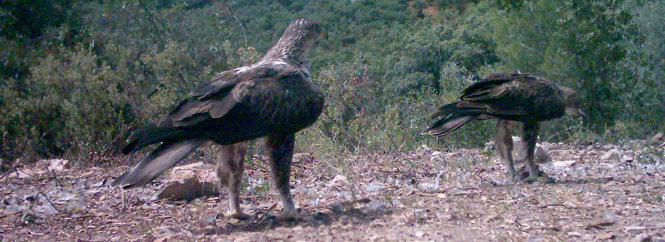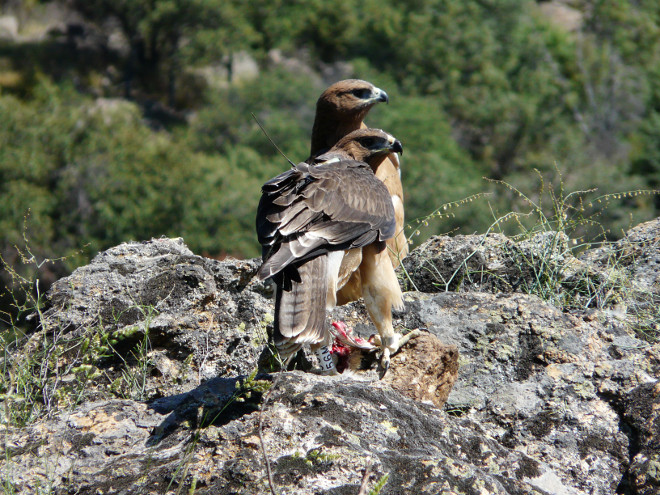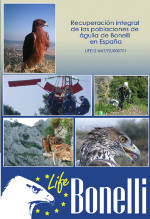
- Details
- Created: 28 November 2013
- Hits: 2434

International Status
The presence of the Bonelli's Eagle fluctuates from northwest Africa and eastern Iberian Peninsula to the Middle East via the Mediterranean Basin. In addition, it is present in southwest Asia, including Arabia, Afghanistan, Pakistan and India, and across the north of Indo-China to the south of China (Del Hoyo et al., 1994). Despite the fact that the population seems to have diminished in the last few years, the species is not considered to be threatened globally. This population decline is allegedly not happening quickly enough (BirdLife International, 2009).
European Status
In Europe, the Bonelli's Eagle is recognised as a threatened species due to its small population size (920 to 1,100 pairs) and due to the fact that it experienced a large decline in almost all its dispersal area between 1970 and 1990. Although some populations remained stable in the 90s (Greece, Portugal or Cyprus), it continued to dwindle in Spain, their main bastion, at a rate of more than 20% as well as in France, Italy and Turkey (BirdLife International, 2004).
Although Spain is home to around 65% of the European population, the rest is irregularly distributed in the Mediterranean Basin. Other EU countries that host breeding populations include France, Greece, Italy and Portugal.
The reasons behind the declining trend in the European population is believed to be based on various factors, such as: hunting, electrocution by overhead electrical cables, disturbance of nesting sites, and loss and deterioration of dry grasslands and other natural environments where fledglings are scattered.
Status in Spain
Despite Spain being one of the countries in Europe where the Bonelli's Eagle (aquila fasciata) is most present, it is one of the raptor species whose conservation status shows a greater variation between the different Spanish regions. A high population density exists in the southern and eastern parts of the Iberian Peninsula, but the population been wiped out in the Balearic Islands, and is very limited in other regions such as Madrid, Álava and Navarre. In these three particular regions, it has been decided to implement recovery plans for the species (strengthening or restoration), from which this current project originates.
Spain is home to a total of 733-768 pairs, mainly present in higher densities along the coastal mountains of the Mediterranean and spread disproportionately inland, where it is less common, except in Extremadura.
The fact that we do not possess valid historical information prevents the establishment of a general trend, but it is considered that the current population is 35% less than that at the end of the 1970s. This dramatic decline was greater in the northern populations (for example, a decrease of 55% in the Castile and León region). The only seemingly stable populations are those in Andalusia and Extremadura (Real, 2004). If the negative trend continues in the northern dispersal area (to the north of Aragón, Navarre, the Basque Country, Castile and León, Madrid, northeast of Castilla-La Mancha) the species could become extinct, whereas in Andalusia and Extremadura there is hope for the future of the species in the Iberian Peninsula with important populations and high breeding numbers.
The decline of the Bonelli's Eagle is in contrast to the stability of other eagles in the country during this same period, as in the case of the Spanish Imperial Eagle (Áquila adalberti) or the Golden Eagle (A. chrysaetos).
Therefore, the project will focus on the recovery/strengthening of the Bonelli's Eagle population in four particular regions: Mallorca, Navarre, Álava and Madrid. The regression of the Bonelli's Eagle population has been detailed in the following regions:
In Mallorca, the species became extinct around 1970, and were the victim of the intense hunting of raptors that occurred across the whole of Europe. It is thought that a breeding population of 10 pairs could have existed, although the specific data of inhabited areas is very limited.
In Navarre, it was thought that between 12-14 pairs were present in the 70s, although verified data of only 8 breeding pairs across former lands that were reduced to only three areas at the beginning of the 90s, of which only one has been inhabited in the last years. Thus, a decline of more than 75% is recognised in only fewer than three generations. At the beginning of this century, nest building was attempted in a new area which was later confirmed to be an important dispersal area for fledglings. However, the species has not managed to breed in this new area.
The leading factors that brought about this sharp population decline from 1984 to 1994 were deaths caused by electrocution/collisions and hunting, along with problems derived from demographic stochasticity and population isolation. Since 1991, large steps have been taken towards the conservation of this species (see previous conservation efforts) by passing laws to protect it and its habitats; mending of overhead electrical cables and measures to decrease hunting and other dangers.
In the Community of Madrid, there are references to breeding of Bonelli's Eagle in 15 different towns between 1974 and 2005. Reliable data only exists for 10 of these pairs from 1985 to 2005. The two pairs that have remained in the same area, since at least the beginning of the 90s, represent only 20% of the pairs known with reliable records in the region. Therefore, this decline is 80% in the last 15-20 years. The main causes of extinction were related to hunting directed at the species and incidents involving overhead electrical cables. At the moment, tensions in hunting and pigeon-breeding communities have eased and a large number of electrical cables have been repaired in the entire area.
There currently only exists one breeding pair in Álava, which also lives in the neighbouring region of Burgos (Castile and León). The number of specimens in Álava constitutes the total population in the Basque Country. The population of the target areas of the project is comprised of the northern boundary the dispersal area of the species in the Iberian Peninsula. The main cause of the extinction in Álava is attributed to habitat loss and dangers and deaths caused by humans.
In contrast, in Andalusia, the population has remained stable during the previous decade, with an estimated population of 354 pairs (essentially half of the Spanish population), located mainly in the Baetic System, except a small proportion based in Sierra Morena.
Andalusia shares its border with Murcia which, besides having the largest geographic area of Spain, currently shows the highest rates of reproduction. This reinforces the importance of this region as it becomes the central dispersal area of the Bonelli's Eagle in Spain (a refuge because of its large population size and a producer of specimens due to its high breeding rates in certain seasons).
Consequently, chicks will be used from this population, combined with recovered birds and those brought up through captive breeding, to restore populations in the target areas.





















